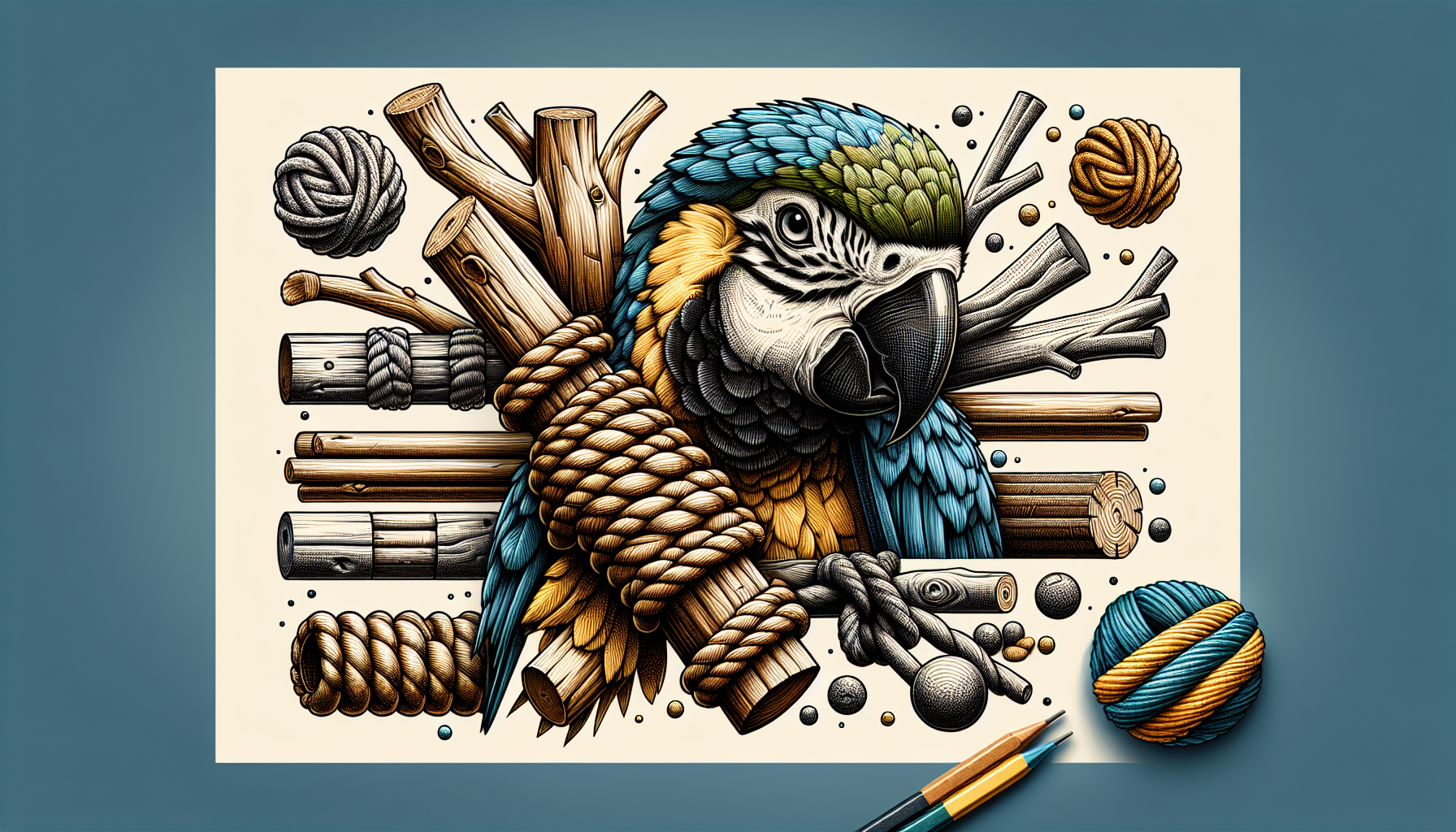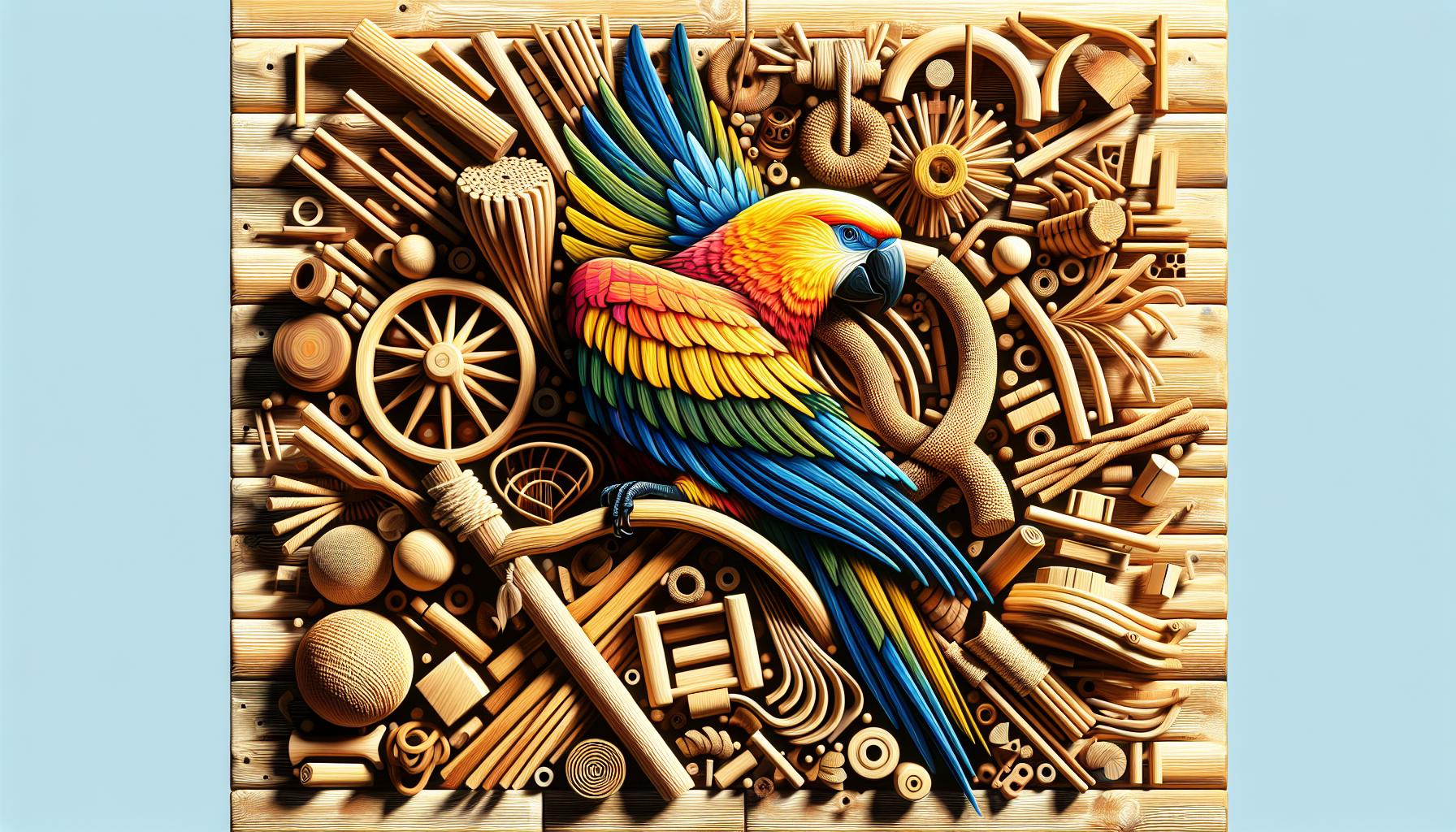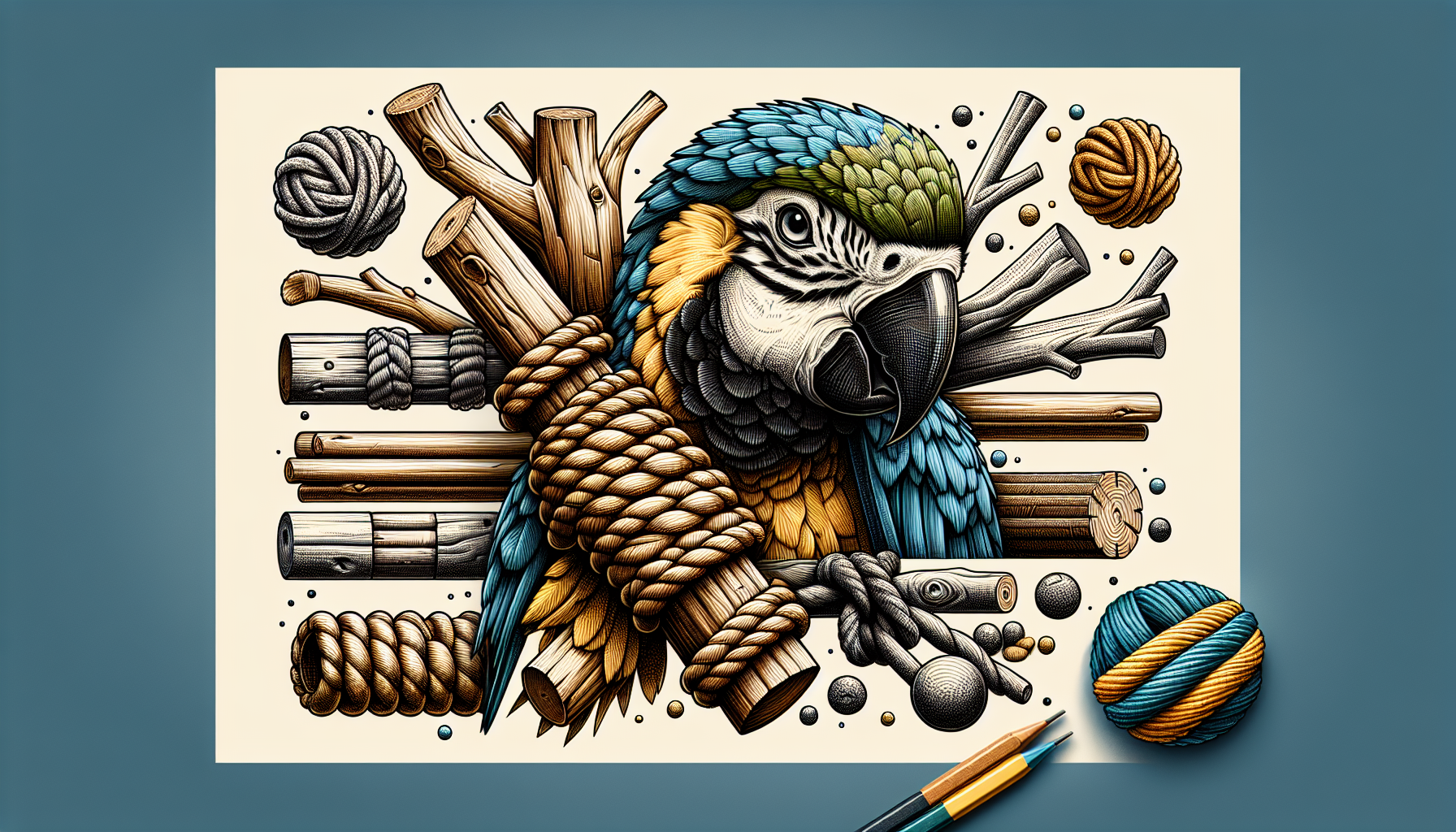Physical Address
304 North Cardinal St.
Dorchester Center, MA 02124
Physical Address
304 North Cardinal St.
Dorchester Center, MA 02124

Parrots are fascinating creatures known for their brilliant colors and playful personalities. As owners, we strive to create the perfect environment for our feathered friends, ensuring their physical and mental well-being. Among the many considerations, one question often arises: “Does a parrot need different types of perches?” This article will explore the importance of variety in perches for parrots, shedding light on how it can enhance their overall health and happiness. Whether you are an experienced parrot owner or new to the world of avian companionship, this information will prove invaluable in creating the ideal habitat for your beloved parrot.

Natural perches are a great option for providing your parrot with a more natural and stimulating environment. These perches are made from branches or logs from trees, mimicking the natural perching surfaces that parrots would find in the wild. Natural perches offer varying diameters and textures, which help exercise your parrot’s feet and promote muscle development. They also provide a more realistic and comfortable perching experience for your feathered friend.
Rope perches are soft and flexible, making them a comfortable option for parrots to perch on. They are usually made from natural fibers or synthetic materials and can be twisted or knotted to create different shapes. Rope perches offer a more forgiving surface for your parrot’s feet, reducing the risk of foot problems. However, it is important to note that rope perches may be more difficult to clean compared to other types of perches.
Wooden perches are a popular choice among parrot owners. They come in various shapes, sizes, and textures, allowing you to offer a variety of perching experiences to your parrot. Wood is a natural material that parrots are naturally inclined to chew on, which helps maintain their beak health and prevent overgrowth. However, one potential drawback of wooden perches is the possibility of splintering, so it is important to regularly inspect them for any signs of damage.
PVC perches are made from a sturdy and durable plastic material. They are easy to clean and maintain, making them a convenient option for busy parrot owners. PVC perches offer a more consistent and uniform surface compared to natural or wooden perches, which can be beneficial for parrots with foot problems. However, PVC has the tendency to absorb heat, so it is important to ensure that the perch is not positioned in direct sunlight or near a heat source.
Concrete perches are specifically designed to help wear down your parrot’s nails and beak. They provide a rough and abrasive surface that naturally files down your parrot’s nails as they grip onto the perch. Concrete perches can be a valuable addition to your parrot’s perch setup, but it is important to ensure that they are not the only type of perch available. The rough texture can be uncomfortable for extended periods of perching, so it is important to offer a variety of perch types for your parrot’s overall comfort.
When choosing perches, it is important to consider the size and diameter that are suitable for your specific parrot species. The perch should be thick enough for your parrot to comfortably grip, without causing strain or potential injury. A perch that is too small may lead to foot problems, while a perch that is too large may be difficult for your parrot to grip onto.
Different perches offer varying textures, which can provide different levels of comfort and stimulation for your parrot. Rough-textured perches can help wear down your parrot’s nails, while smoother perches may be more comfortable for extended periods of perching. Offering a variety of textures can help keep your parrot’s feet healthy and engaged.
Parrots thrive on variety, so it is important to offer a diverse range of perches in their environment. This includes different materials, shapes, and sizes. Providing a variety of perches can help prevent boredom and encourage your parrot to engage in different perching positions and activities.
In the wild, parrots are accustomed to perching at different heights. By offering perches at varying heights in your parrot’s cage or aviary, you can provide a more stimulating and dynamic environment. This can also encourage your parrot to exercise by flying or hopping between perches.
The placement of perches is crucial for your parrot’s comfort and safety. Avoid placing perches too close to food or water dishes, as droppings can contaminate them easily. It is also important to ensure that there is enough space for your parrot to move around and stretch its wings without obstruction from perches or other cage accessories.
Different types of perches offer varying levels of exercise and muscle development for your parrot. Natural and wooden perches with varying diameters can help strengthen your parrot’s foot muscles and promote overall coordination. Rope perches offer a more challenging surface, requiring your parrot to engage its muscles for balance and stability.
Parrots’ beaks and nails constantly grow, and different types of perches can help naturally maintain them. Wooden perches encourage chewing, which helps trim the beak and prevent overgrowth. Concrete perches provide a rough surface that files down the nails as your parrot grips onto them.
Offering a variety of perches creates a more interesting and mentally stimulating environment for your parrot. Different textures, shapes, and heights can keep your parrot entertained and engaged, preventing boredom and encouraging natural behaviors.
Parrots spend a significant amount of time perching, and providing comfortable perches is essential for their overall well-being. Different perch materials and textures allow your parrot to choose the most comfortable perching surface for different activities and rest.
By offering perches with varying diameters and textures, you can help prevent foot problems such as bumblefoot or arthritis. The different surfaces promote healthy foot muscles and prevent strain or pressure points.

Wooden perches, especially those made from softer woods, can splinter over time. These splinters can cause injury to your parrot’s feet, so it is important to regularly inspect wooden perches for any signs of damage and replace them as needed.
Rope perches can be more challenging to clean compared to other types of perches. The fibers can trap dirt, droppings, and food particles, which can become a breeding ground for bacteria. Regular maintenance and cleaning are essential to ensure a hygienic environment for your parrot.
PVC perches have the tendency to absorb heat, which can be uncomfortable for your parrot, especially if the perch is positioned in direct sunlight or near a heat source. It is important to monitor the temperature of PVC perches and provide shade or an alternative perch if necessary.
While concrete perches can be beneficial for wearing down your parrot’s nails, they can also be abrasive on their sensitive feet. It is essential to offer other types of perches that provide a more comfortable surface for your parrot, ensuring their overall foot health and comfort.
Certain types of perches, such as rope perches or perches with irregular shapes, may cause your parrot to perch in unnatural positions. This can potentially lead to muscle strain or discomfort. It is important to observe your parrot’s perching behavior and ensure that they have access to perches that promote natural and comfortable perching positions.
When introducing new perches to your parrot’s environment, it is important to do so gradually. Start by placing the new perch near existing perches and observe your parrot’s response. Allow your parrot to become familiar with the new perch at its own pace to ensure a smooth transition.
Observe your parrot’s behavior and body language when introduced to new perches. Some parrots may take to them immediately, while others may need more time to adjust. Pay attention to any signs of discomfort or resistance and adjust accordingly.
Offer a variety of perches at different heights, textures, and materials. This provides your parrot with options to choose from and encourages natural behaviors. Your parrot may have preferences for certain types of perches, so it is important to provide a range of options.
Rotating perches can help prevent boredom and encourage your parrot to utilize different perching surfaces. This can be as simple as swapping perches from one location to another or replacing them with different types of perches periodically.
It is important to ensure that the perches are securely installed and stable. Parrots rely on their perches for safety and stability, so wobbly or unstable perches can cause stress or even injury. Regularly inspect the perches and make any necessary adjustments or replacements to ensure your parrot’s safety and comfort.
Natural branches or wooden perches provide a more authentic perching experience for your parrot, mimicking the surfaces they would encounter in their natural habitat. The varying shapes and textures of these perches offer a more dynamic environment and encourage natural perching behaviors.
Swinging perches can provide an element of fun and play for your parrot. They simulate the movement of branches in the wind, providing your parrot with a more stimulating and engaging perching experience. Swinging perches can also promote exercise and balance.
Providing perches with different textures, such as rough or smooth surfaces, mimics the diversity of perching options that parrots encounter in the wild. This encourages the development and maintenance of healthy foot muscles and promotes natural behaviors.
In the wild, parrots perch at various heights to explore their surroundings and avoid predators. By offering perches at different heights in your parrot’s environment, you can create a more dynamic and stimulating setting that mimics their natural habitat.
Parrots encounter various perch widths in the wild, from narrow branches to wider surfaces. Offering perches with different diameters allows your parrot to experience a range of perching surfaces, improving foot health and muscle development.
A well-rounded perch setup should include a mix of different perch types, textures, and sizes. This provides your parrot with a more varied and engaging environment, offering opportunities for exercise, comfort, and mental stimulation. Experiment with different combinations to find what works best for your individual parrot.
Consider the activities your parrot engages in and adjust the perch setup accordingly. For example, if your parrot enjoys foraging or playing with toys, provide perches near these activities to encourage movement and engagement. Similarly, if your parrot enjoys a specific height for sleeping, offer perches at that level to ensure a comfortable resting spot.
Observe your parrot’s behavior and preferences to tailor the perch setup to their individual needs. Pay attention to which perches they gravitate towards or spend the most time on. This can guide you in providing the types of perches that your parrot finds most comfortable and appealing.
Ensure that there are enough perches in your parrot’s environment to accommodate their natural perching and resting needs. Having multiple perches allows your parrot to move around and change positions, promoting natural behaviors and overall well-being.
Distribute perches throughout your parrot’s living space to encourage movement and exploration. This provides opportunities for exercise and mental stimulation. Place perches near food and water sources, as well as close to toys and other enrichment activities.
Regularly inspect your parrot’s perches for signs of damage, wear and tear, or contamination. Look for splintering in wooden perches, fraying in rope perches, and any buildup of dirt or droppings. Identifying and addressing issues early on can help prevent potential problems and ensure your parrot’s safety and comfort.
The frequency of perch cleaning depends on your parrot’s habits and the type of perch. Perches that are used for feeding or contain toys may require more frequent cleaning. It is generally recommended to clean perches every one to two weeks, but adjust the cleaning schedule based on your parrot’s needs and the condition of the perches.
Different types of perches require different cleaning methods. Natural and wooden perches can be cleaned by scrubbing with a brush and mild soap. Rinse thoroughly and allow them to air dry before reinserting them into the cage. For rope perches, soaking them in warm soapy water and gently scrubbing can help remove dirt and debris. PVC perches can be wiped clean with a damp cloth or sponge.
After cleaning, it is important to ensure that the perches are completely dry before placing them back in the cage. Moisture can promote the growth of bacteria or mold. If you suspect any contamination, disinfect the perches by soaking them in a pet-safe disinfectant solution or a mixture of water and white vinegar. Rinse thoroughly and allow them to dry before reintroducing them to your parrot’s environment.
If you notice any signs of damage, wear, or contamination that cannot be adequately addressed through cleaning and maintenance, it is important to replace the perches. Damaged or worn-out perches can compromise your parrot’s safety and comfort. Regularly inspect your perches and replace them as needed to ensure a clean and safe environment for your parrot.
Providing your parrot with a variety of perches is essential for their physical and mental well-being. Different types of perches offer unique benefits, such as exercise, beak and nail maintenance, mental stimulation, comfort, and foot health. By considering the size, texture, variety, height, and placement of perches, you can create an environment that mimics a natural setting and promotes a happy and healthy parrot. Regular maintenance and cleaning of perches are crucial for ensuring your parrot’s safety and overall health. Remember to monitor your parrot’s preferences and adjust the perch setup accordingly to provide the best possible environment for your feathered friend.

My name is Shane Warren, the author behind Your Bird Buddy – your ultimate guide to the wonderful world of birds! Unleash your inner avian explorer as we delve into a vibrant library of knowledge dedicated to all things feathered. From learning about diverse bird species from across the globe to understanding their captivating habitats and behaviors, I’m here to fuel your passion for these magnificent creatures. Not only that, but I also provide valuable insights on being a responsible and informed pet bird owner. Join our vibrant community and let’s celebrate the feathered wonders of the world together – one chirp at a time. And be sure to join our Your Bird Buddy Community over on Facebook!